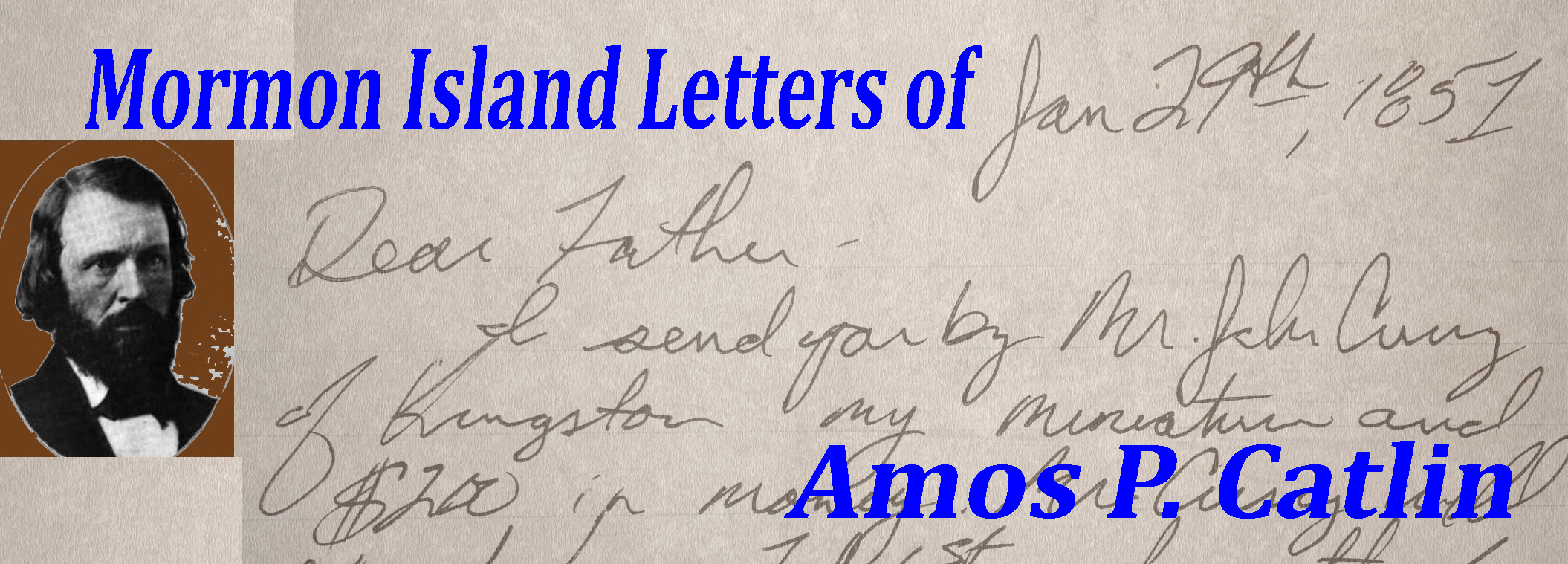
Three letters that Amos P. Catlin wrote to his father in Kingston, New York, speak more to the anxieties of Amos than the mining conditions at Mormon Island. The letters, spanning a time frame of January 1851 to March 1852, are notable for their change in tone over time. The private letters to his family offer a contrast to Amos Catlin’s public life. Notably, while Amos expresses a desire to return home, his actions at Mormon Island and Sacramento indicate a man who is building a new life in California.
The following three letters come from the archives of the Huguenot Historical Society in New Paltz, New York. Correspondence to Pierce Catlin from Amos Catlin, January 29, 1851, June 28, 1851, and March 18, 1852, Correspondence (1810-1852 and undated), David and Pierce Catlin Family Papers, Historic Huguenot Street, New Paltz, NY.
January 28, 1851
Amos Catlin arrived in California in July of 1849 and made his way up to the Mormon Island gold mining district by August. The first letter to his father Pierce Catlin in Kingston, Ulster County, New York, is dated January 29th 1851 and sent from San Francisco. He tells his father that he is still at Mormon Island, indicating that there were previous letters back home. But if he is still residing at Mormon Island, why is Amos writing letters from San Francisco?
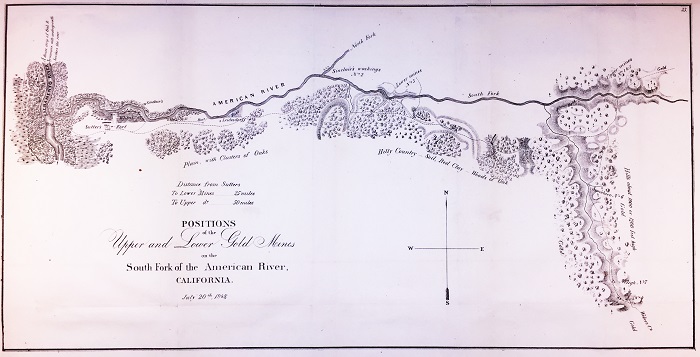
Sacramento was gripped by a cholera outbreak in late October 1850. It killed scores of people including many doctors who were attempting to care for the afflicted. Amos writes, “I was driven out by the cholera which killed 1/10 of the population.” It was estimated that 80 percent of Sacramento’s residents had fled the city. Amos was among them.
Amos recounts that he has attempted to start working in his profession as a lawyer in Sacramento. Catlin had a brief law partnership with John Curry who he knew from his time practicing law in New York. He informs his father that he has given John Curry $200 and a miniature photograph to be delivered to Pierce Catlin upon Curry’s return back east.
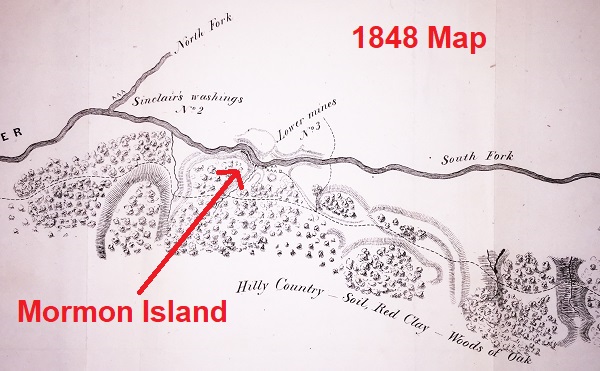
A large portion of the 1851 letter is devoted to Amos’ accounts back in New York. With the money Amos sent to his father, he wanted him to settle two outstanding debts of $25 and $30 to different individuals. Amos then states, “Beyond these, I owe nothing at home.” He then tacks on that he wished he could send his father more money to settle Pierce Catlin’s mortgages. Pierce Catlin had bounced around from different occupations including school teacher, wagon-maker, and farmer.
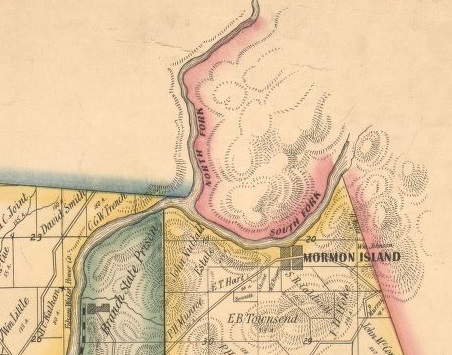
Amos assures his father he is in good health and he writes, “I keep hoping for the ‘good time that’s coming’”. That Amos put “good time that’s coming” in quotation marks must have been an optimistic or slightly sarcastic expression among the miners in California. Amos is optimistic, at least in the letter, that he will be able to earn enough money to come home in another year. All of Amos’ letters state he hopes to return home in another year.
While it is difficult to speculate about the intention and motivations of any author of a letter so long ago, Amos explicitly states that he has his reasons why he does not want his father to reveal that he has sent him the $200. However, he does not reveal those reasons in the letter. The money was more than enough to settle his debts. We learn in a later letter that the Peirce Catlin household may have been light on cash.
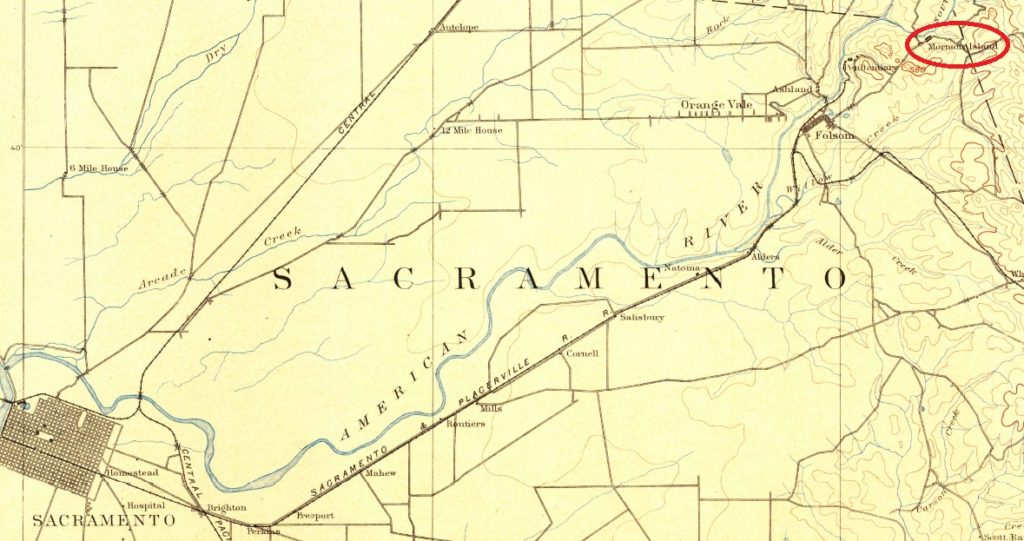
Amos includes a post script in the margin of the first letter. He instructs that all future correspondence should be addressed to him and sent to Sacramento City. He obviously was not staying in San Francisco much longer and Mormon Island did not have a post office at the time. He also apologizes for not sending specimens of gold back to his sisters, as he did not bring them with him to San Francisco.
By the time Amos Catlin arrived at Mormon Island on the South Fork of the American River in the summer of 1849, gold mining was in full swing. The Mormon Island Mining Association had already been established and work was progressing at damming and diverting the river for mining purposes. Every lineal foot of the river was either under a mining claim or being actively mined. It is doubtful that Amos worked for any length of time as a miner washing dirt in a pan or long tom sluice box. Had he wanted his own mining operation, he could have travelled up any one of the forks of the American River and staked a claim. But he did not do that.
June 28, 1851
The second letter in the archive is dated five months later on June 28, 1851, from Mormon Island. Even though Amos notes he has written two previous letters to his father, and he has received some correspondence from other family members, there has been no information as to whether his father has received the money he sent last January. He even admonishes his father, “I am much annoyed at receiving no intelligence of it [$200] after a period of five months.”
Amos writes that he is pleased that he continues to receive the Ulster Republican newspaper and instructs his father to renew the subscription out of the money he sent him. He tells his father to direct all correspondence, including the newspaper, to Mormon Island as the town now has a post office and the Post Master is John Shaw.
The weather has been very warm he writes, which would be typical of the Mormon Island region in June. Amos relates that his health is good and that he has escaped the dysentery thus far. He even mentioned having diarrhea in his first letter home. Such intestinal problems were common when drinking water was pulled right out of the river that had already flowed by hundreds of men, and animals, wading in the water mining for gold.
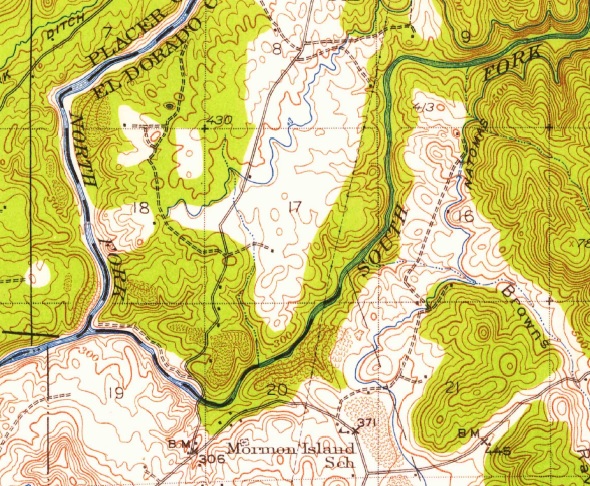
The next paragraph of information tells us that Amos was not physically mining, but speculating and investing in mining claims. He had invested about $3,000 in various mining claims and hoped they would appreciate up to $10,000 by next winter. Regardless of his optimistic outlook he reported that, “…uncertainty governs everything here.”
Again, he instructs his father to write to him about the money he sent home. “I am very anxious to know whether Curry paid you $200 for me.” As leverage to get the information he desires about the money, Amos states, “I shall not write any more until I get some letters.” He wanted his father to persuade his mother and sisters to write more frequently. He closes, “As ever, your affectionate son.”
The tone of the second letter is more composed than the first. What comes across is a man who is protective of his image of being honest and ethical. He really needs to know if the money he sent home paid the debts he says he forgot to pay before he left for California. He is also being cautious about what he reveals to his father and family. He does want to lead them to think he has, or will, strike it rich.
It’s possible that in previous letters Amos wrote he was more descriptive of his life at Mormon Island. We know that he was representing some people before the Alcalde of the district in his profession as a lawyer. The first political mention of Amos in a Sacramento newspapers is of him being elected the chairman of a meeting of the Whig Party at Mormon Island. He was then elected as a representative to the Sacramento County Whig Central Committee from Mormon Island in early June 1851. Perhaps he failed to mention his political involvement because he did not want his family to assume he was becoming too comfortable in California and would never return home.
March 18, 1852
The third letter is dated March 18th, 1852, from Mormon Island, and is a stark contrast to the previous two letters. There is much more information, but more importantly, it does not have the rushed penmanship of the earlier letters. Instead of opening with a curt demand for information from his father, Amos opens with appreciation of knowing his father’s health is good. He throws in an almost obligatory line of homesickness, but then counters with, “…it will never answer for me to come home now unless I have enough to live upon.”
Amos then struggles to explain why he can’t come home and the nature of his situation. He obviously has certain expectations of himself that he has not yet met. Furthermore, his financial affairs have become more complicated. His business interests, as with all mining claims that ebb and flow in value with the season and the most recently posted gold yields, make it difficult, to forecast the value of the investment. In his words, “Yet, I do say that my affairs are so situated that I could not wind up as well now as I could have done at many times heretofore.” In other words, if he liquidated his investments now, he would lose money compared to an earlier point.
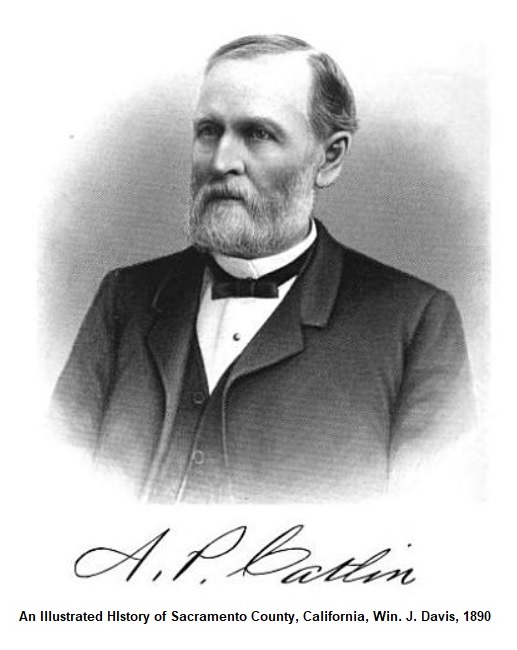
Gold mining was an abstract and foreign concept to most people on the east coast who had never been to California. Amos even concedes, “It would be useless for me to attempt to explain to you the nature of operations in which I am engaged. They are quite different from affairs at home. I am interested to some extent in quartz veins, damming companies, and water companies.”
Kingston, New York, is in the Hudson river valley. The Hudson river can be over one mile wide in spots and it rains in the summer. The South Fork of the American River, by contrast, at Mormon Island was scarcely 200 yards wide, shallow, and the surrounding landscape is a desert in summer. Amos was at a loss to easily and effectively describe the mining operations that required dams across the river or water canals above it.
The one line of business Amos did try to explain was his investment in a steam engine for a saw mill. He thought the saw mill would produce him the most income, and he was proud of his investment. “The engine belongs to me, a beautiful 12 horse locomotive which cost me $3,000.” He then goes on to loosely explain the business arrangement and business proposition. We also learn that he was the main salesman for the operation.
Amos then bemoans the fact that he must keep a saddle horse, apparently for visiting different mining locations trying to sell lumber. The barley he must feed the horse costs 18 cents per pound and the horse eats $1 a day. Hay, fortunately, is cheap at 6 cents per pound. Then he adds, “When I am not making money, I am going backward fast. But I hope to shape things for home next summer.”
In the spring of 1852 Mormon Island was hit with a flood; a combination of heavy rain and melting snow. Amos estimates he lost about $1,500 in property. He writes how the unexpected flood was terrible, carried off many structures, and inundated Sacramento. He was correct. The 1852 March floods ripped all of the bridges off of their foundations across the American River forks in the mining region. As Amos’ letter was dated March 18th, the huge flooding event had occurred only a week earlier.
A paragraph is devoted to the fortunes of William (relationship unknown), whom Amos recently received a letter from. William is now in New Orleans and gave no mention of traveling to California in his letter. Amos is concerned about William and thinks he could put him in a job earning $2,000 per year if William were to travel to California. But Amos doesn’t want his father to mention any possible California employment to William until Amos can confirm an employment opportunity.
Amos is rather perturbed to learn his father had sold his farm and bought a grist mill at Rhinebeck, on the other side of the Hudson river from Kingston. In kind of an astonishing and raw statement, Amos writes, “Every time I hear of your making a trade of your property, I imagine that you are the loser.” There is a lot family history being conveyed in Amos’ assumption of the transaction. However, Amos is resigned to the fact that he can do nothing, and say nothing, about the merits of the farm for grist mill trade. He just writes, “In your next, let me know more particulars about it.”
The last page of the letter illustrates that Amos is genuinely homesick. He wants Margaret and Jane (relationship unknown, but possibly sisters) to write more often. Amos writes that he often thinks of them and wonders how they look and what they are doing. In a line tinged with a little bit of pity or depression, Amos writes, “I shall consider that they have forgotten me unless they write to me sometimes and tell all the current news among the young people.” He also wants Emily (relationship unknown) to write and tell him all the “gossip” from “old Palz.” (New Paltz is a village south of Kingston where the Huguenot Street Museum is located.)
Amos continues that no one understands how important the news from home is to a guy like him living “among strangers.” He will gladly read about the trivial matters enveloping the lives of his family and friends. He laments he can offer nothing of interest from his life to them. His pitiful lament of not leading a life worth writing about is contrary to the facts.
The previous summer in July 1851, Amos was nominated by the Whig Party for a California Assembly seat. He would lose that election, but he stayed involved with politics until he was elected to the Senate the following year. Also, in July, he was invited to address a large Miners’ Convention at Mormon Island, partly on the strength of his legal views and experience in the mining industry. He would also become a correspondent for the Sacramento Daily Union. He put together an impressive report on all of the mining companies at Mormon Island, the length of their claim, number of shares in the company, and gross revenue from 1849 through 1851.
As an investor in some of these claims, Amos put an optimistic spin on his report. He wrote, “The courses of the currents will be shifted in consequence of the great changes produced by digging, and by the erection of dams, and places; now known to be rich, will be swept by the waters and their golden deposits carried into the claim of some lucky company below. The upturned bars, the piles of poor earth will be sluice-washed by the torrent, the gold lodged in crevices and pockets, and the sand again formed into bars and banks. Let industry increase, economy be practiced, skill be applied, and desires moderated and the results will be the same. A. P. C. Mormon Island, Oct. 27th, 1851.
In March of 1852, when he wrote the third letter, Amos was in the midst of forming the Natoma Water and Mining Company. His vision, which was fulfilled, was to place a dam across the South Fork of the American River above Salmon Falls, and then run multiple water canals down to Mormon Island and beyond. Amos had plenty to write about, he just chose not to share it, at least not in these letters.

He finishes up his letter to his father with request to be remembered to Mr. Clark and that he does not know where David Beach is. Amos expresses hope that he will return home before the end of another year. He also enclosed another miniature photograph, which he hoped would reach them in better shape than the first daguerreotype that he had previously sent. He instructs, “Put a glass over it in a light frame and it will look as well as if it were done on ivory.”
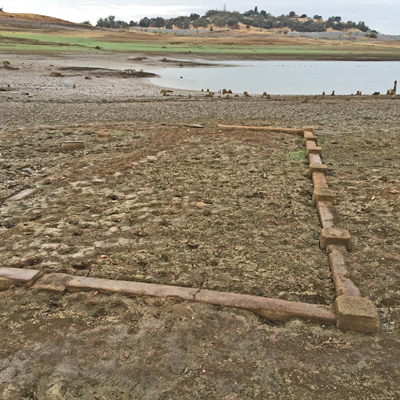
From these letters we learn that Amos Catlin was a humble man. He was concerned more with his family back home, then announcing his modest notoriety or the success he was having in California. While Amos wrote other letters to his father to share with his family, from the tone and content of these specimens, it is doubtful he ever outlined the wild west life that was happening around him. Perhaps he figured they were reading about it in the newspapers.
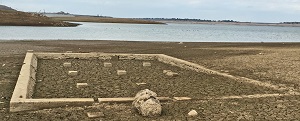
Amos would never move back home to New York. His life became part of the fabric of Sacramento and California history. He sponsored the 1854 legislation as Senator to permanently move California’s Capitol to Sacramento. He argued on behalf of the original map of the important Leidesdorff land grant before the U. S. Supreme Court and won. Amos would move to Sacramento and become a prominent attorney and raise a family. At different times he was nominated for Governor and a California Supreme Court Justice. In 1890 he was elected a Superior Court Judge in Sacramento County.
The three letters that we have from Amos to his father fits Amos’ persona throughout his life. He was a detail-oriented man, concerned with the welfare of others, and always modest and humble. While the letters are not particularly enlightening about events surrounding the Gold Rush in California, they do reinforce the public perception of Amos P. Catlin. He was a good man who tried to lead a good life, and do right by others.
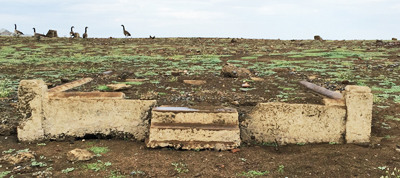
The town of Mormon Island no longer exists. It sits below the waters of Folsom Lake. At the very lowest water levels of Folsom Lake, the Mormon Island school house foundation will poke out, and remnants of the Mormon Island Cemetery are visible.
Thank you to the HISTORIC HUGUENOT STREET | A NATIONAL HISTORIC LANDMARK DISTRICT SINCE 1960 Mailing Address: Roosa House | 88 Huguenot Street | New Paltz, NY 12561 | www.huguenotstreet.org | (845) 255-1660
